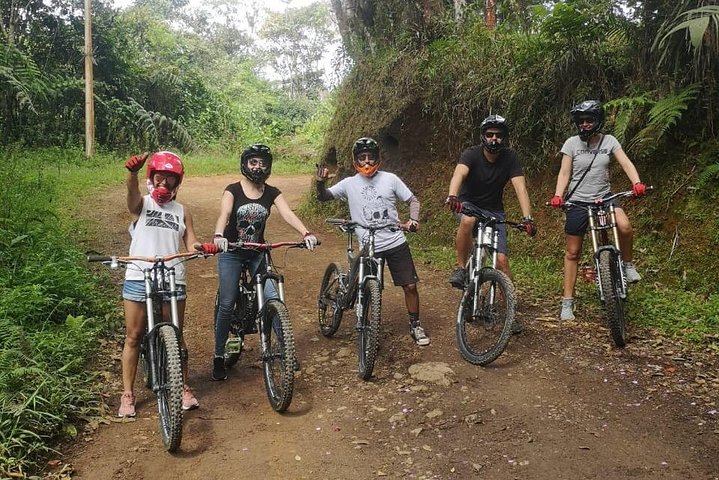Gravity and Green: Riding the Western Andes into Cali
A cloud-forest descent from tea-covered highlands to the salsa city below
Mist loosens its grip on the ridgeline as the Western Andes exhales. The cloud forest stirs—leaves bead silver, bromeliads blink awake, and the road unfurls like a ribbon pulled free. You swing a leg over the bike, clip in, and the mountain tips you forward, not with a shove but with a steady invitation. Gravity does the talking; the forest answers in birdsong and the rush of tires over wet grit. Cali waits below, sunlit and warm, but up here the air stays cool, scented with earth and tea.
Trail Wisdom
Brake smart, not hard
Feather both brakes and alternate pressure on long pitches to avoid overheating rotors and hand fatigue.
Layers for the cloud forest
A light, packable rain shell keeps mist and wind off at higher elevations where temperatures drop quickly.
Eyes up in the corners
Moisture can slick the apex and hide gravel; scan ahead and set speed before entering turns.
Hydrate early, often
Cool air can mask sweat loss—aim to sip every 10–15 minutes to stay sharp on the descent.
Local Knowledge
Hidden Gems
- •Bitaco Tea region near La Cumbre for cloud-forest views and a rare Colombian tea landscape
- •Mirador at Kilómetro 18 along the old road for roadside arepas and cool mountain air
Wildlife
Hummingbirds in the cloud forest edges, Toucanets and tanagers along forested corridors
Conservation Note
Cloud forests are biodiversity hotspots and sensitive to erosion—ride on established roads, avoid skidding, and pack out everything. Respect gates and farm access; many lanes pass through private land.
Founded in 1536, Cali grew on trade routes linking the Andes and the Pacific. The Bitaco Tea project near La Cumbre is Colombia’s only commercial high-mountain tea operation.
Seasonal Guide
spring
Best for: Lush cloud-forest scenery, Cooler uphill temps
Challenges: Frequent showers, Slick surfaces
March–May is rainy in the Andes. Expect vivid greens, moody fog, and wet roads—beautiful but slower riding.
summer
Best for: Clear valley views, Drier road surfaces
Challenges: Midday heat at lower elevations, Afternoon winds
June–August trends drier, with crisper mornings up high and warmer finishes in Cali—prime for big panoramas.
fall
Best for: Quieter roads, Balanced temps
Challenges: Rain returns in Oct–Nov, Variable visibility
September starts stable, but October–November bring second rains. Flexible riders get rich color and fewer crowds.
winter
Best for: Consistent riding windows, Festive city atmosphere
Challenges: Passing mountain showers, Holiday traffic near towns
December–February often sees drier spells with quick showers. The city hums with events and warm evenings.
Photographer's Notes
What to Bring
Half-finger or full-finger bike glovesEssential
Improves grip on wet levers and protects hands during long braking sections.
Lightweight waterproof shellEssential
Cloud forest mist and showers are common; a shell keeps you warm and dry without bulk.
2-liter hydration system or bottlesEssential
Staying hydrated is key during sustained descents when cool air masks fluid loss.
Front and rear bike lights
Fog and low clouds can reduce visibility—small lights increase your margin of safety.
Common Questions
Do I need prior mountain biking experience?
Basic bike handling and comfort with braking on long descents are recommended. The route follows rural roads with mixed surfaces rather than technical singletrack.
Are bikes and helmets provided?
Most guided trips include bikes and helmets; confirm equipment details, sizes, and availability when booking.
What kind of terrain will we ride?
A mix of paved rural lanes, hardpack, and occasional gravel or potholes, with a net descent from cloud forest to the city.
Is lunch included?
A picnic stop by the tea fields is typically part of the experience—check your confirmation for specifics and dietary options.
How do we get to the start and back from the finish?
Trips usually include a vehicle shuttle from Cali to the highlands and a return or drop-off in the city; verify pickup points and times after booking.
What happens in bad weather?
Rain is common in the Andes. The ride generally proceeds with extra caution unless conditions are unsafe; your guide will make the call and adjust the route as needed.
What to Pack
Light rain shell for cloud-forest mist; Full-finger gloves for grip on wet levers; Sunscreen and sunglasses—UV is strong even in fog; Small cash for roadside snacks and tips
Did You Know
The Bitaco region near La Cumbre hosts Colombia’s only commercial tea plantation, producing high-mountain teas at the edge of a protected cloud forest.
Quick Travel Tips
Book a morning departure for quieter roads and steadier weather; Start hydrated and eat lightly—descending can mask energy dips; Expect cooler temps up high and hot sun in Cali—pack layers; Confirm hotel pickup and end-point drop-off to streamline your day
Local Flavor
Post-ride, head to San Antonio for coffee and views, then tuck into Pacific coast flavors—try encocado (coconut seafood) or aborrajados (cheese-stuffed plantains). For nightlife, La Topa Tolondra is a legendary salsa spot where locals and visitors mix. If you’re tea-curious, look for Bitaco varieties on local menus and in specialty shops.
Logistics Snapshot
Closest airport: Alfonso Bonilla Aragón International (CLO), ~30–45 minutes from central Cali. Typical trailhead: highlands near Kilómetro 18/La Cumbre, 45–90 minutes by shuttle. Cell service: spotty to none in the upper sections; better near towns. Permits: none required for rural roads—respect private property and follow guide instructions.
Sustainability Note
You’ll ride through sensitive cloud-forest corridors and working farms—stay on the route, skip skids that cause erosion, and carry a reusable bottle to cut single-use plastic. Support operators who contribute to local conservation in the Bitaco area.

